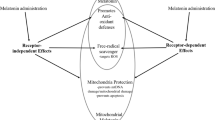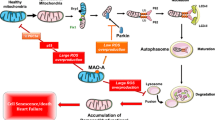Abstract
Postoperative cognitive dysfunction may be associated with the toxic products of lipid peroxidation, such as the α,β-unsaturated aldehyde acrolein, which accumulates in aging. We previously identified an acrolein-mediated, serotonin-derived melanoid product, or SDM. This study further characterizes this putative novel neuromelanin, which is not made from catecholamines. In addition to its strong protein-binding properties, we observed that SDM binds Fe2+ readily and exhibits complex redox characteristics. SDM may exist as a two-dimensional network of polymers that coalesce into larger entities exhibiting electroactive properties. These observations suggest that SDM may contribute to the decline in cognition due to focal degeneration from SDM-mediated free-radical production. We know that inhalational anesthetics sequester acrolein, which is toxic to neurons, and we propose that the local increase in acrolein depletes serotonin levels and enhances neuronal vulnerability through the production of neuromelanin-like structures, such as SDM.







Similar content being viewed by others
References
Allegri G, Vogliardi S, Bertazzo A, Costa CV, Seraglia R, Traldi P (2003) Involvement of 5-hydroxytryptophan in melanogenesis. Adv Exp Med Biol 527:723–730
Ancelin ML, de Roquefeuil G, Ledésert B, Bonnel F, Cheminal JC, Ritchie K (2001) Exposure to anaesthetic agents, cognitive functioning and depressive symptomatology in the elderly. Br J Psychiatry 178:360–366
Bohnen N, Warner MA, Kokmen E, Beard CM, Kurland LT (1994a) Alzheimer’s disease and cumulative exposure to anesthesia: a case-control study. J Am Geriatr Soc 42:198–201
Bohnen N, Warner MA, Kokmen E, Kurland LT (1994b) Early and midlife exposure to anesthesia and age of onset of Alzheimer’s disease. Int J Neurosci 77:181–185
Huether G, Fettkötter I, Keilhoff G, Wolf G (1997) Serotonin acts as a radical scavenger and is oxidized to a dimer during the respiratory burst of activated microglia. J Neurochem 69:2096–2101
Iuliano L (1992) Mechanism of reaction of a suggested superoxide-dismutase mimic, Fe(II)-N, N, N′, N′-tetrakis (2-pyridylmethyl) ethylenediamine. Arch Biochem Biophys 293:153–157
Johnson T, Monk T, Rasmussen LS, Abildstrom H, Houx P, Korttila K et al (2002) Postoperative cognitive dysfunction in middle-aged patients. Anesthesiology 96:1351–1357
Jones CE, Underwood CK, Coulson EJ, Taylor PJ (2007) Copper induced oxidation of serotonin: analysis of products and toxicity. J Neurochem 102:1035–1043
Kastner A, Hirsch EC, Lejeune O, Javoy-Agid F, Rascol O, Agid Y (1992) Is the vulnerability of neurons in the substantia nigra of patients with Parkinson’s disease related to their neuromelanin content? J Neurochem 59:1080–1089
Lindquist NG, Larsson BS, Lydén-Sokolowski S (1988) Autoradiography of [14C]paraquat or [14C]diquat in frogs and mice: accumulation in neuromelanin. Neurosci Lett 93:1–6
Lovell MA, Xie C, Markesbery WR (2001) Acrolein is increased in Alzheimer’s disease brain and is toxic to primary hippocampal cultures. Neurobiol Aging 22:187–194
Meguro R, Asano Y, Odagiri S, Li C, Shoumura K (2008) Cellular and subcellular localizations of nonheme ferric and ferrous iron in the rat brain: a light and electron microscopic study by the perfusion-Perls and -Turnbull methods. Arch Histol Cytol 71:205–222
Miller ED, Fibuch EE, Seidler NW (2010) Toxicity of a serotonin-derived neuromelanin. Biochem Biophys Res Comm 391:1297–1300
Muravchick S, Smith DS (1995) Parkinsonian symptoms during emergence from general anesthesia. Anesthesiology 82:305–307
Poon HF, Calabrese V, Scapagnini G, Butterfield DA (2004) Free radicals and brain aging. Clin Geriatr Med 20:329–359
Roberts RD, Fibuch EE, Heal ME, Seidler NW (2007) Production of a novel neuromelanin at the sevoflurane-water interface. Biochem Biophys Res Comm 363:77–81
Rota C, Fann Y, Mason R (1999) Phenoxyl free radical formation during the oxidation of the fluorescent dye 2′, 7′-dichlorofluorescein by horseradish peroxidase. J Biol Chem 274:28161–28168
Seidler NW, Michelson RC (2007) Polymer templates have an organizing effect on Aβ aggregation. In: Chan AP (ed) Alzheimer’s disease research trends. Nova Science Publishers, New York, pp 23–56
Smaniotto A, Comai S, Bertazzo A, Costa CV, Allegri G, Seraglia R et al (2006) A mass spectrometric investigation on the possible role of tryptophan and 7-hydroxytryptophan in melanogenesis. J Mass Spectrom 41:921–930
Steinmetz J, Christensen KB, Lund T, Lohse N, Rasmussen LS (2009) ISPOCD Group, Long-term consequences of postoperative cognitive dysfunction. Anesthesiology 110:548–555
Sulzer D, Bogulavsky J, Larsen KE, Behr G, Karatekin E, Kleinman MH et al (2000) Neuromelanin biosynthesis is driven by excess cytosolic catecholamines not accumulated by synaptic vesicles. Proc Natl Acad Sci USA 97:11869–11874
Volicer L, Chen JC, Crino PB, Vogt BA, Fishman J, Rubins J et al (1989) Neurotoxic properties of a serotonin oxidation product: possible role in Alzheimer’s disease. Prog Clin Biol Res 317:453–465
Wakamatsu K, Fujikawa K, Zucca FA, Zecca L, Ito S (2003) The structure of neuromelanin as studied by chemical degradative methods. J Neurochem 86:1015–1023
Whittington RA, Virag L (2006) Isoflurane decreases extracellular serotonin in the mouse hippocampus. Anesth Analg 103:92–98
Wilczok T, Stepien K, Dzierzega-Lecznar A, Zajdel A, Wilczok A (1999) Model neuromelanins as antioxidative agents during lipid peroxidation. Neurotox Res 1:141–147
Williams TI, Lynn BC, Markesbery WR, Lovell MA (2006) Increased levels of 4-hydroxynonenal and acrolein, neurotoxic markers of lipid peroxidation, in the brain in Mild Cognitive Impairment and early Alzheimer’s disease. Neurobiol Aging 27:1094–1099
Wrona MZ, Dryhurst G (1990) Electrochemical oxidation of 5-hydroxytryptamine in aqueous solution at physiological pH. Bioorg Chem 18:291–317
Wrona MZ, Goyal RN, Turk DJ, Blank CL, Dryhurst G (1992) 5, 5′-Dihydroxy-4, 4′-bitryptamine: a potentially aberrant, neurotoxic metabolite of serotonin. J Neurochem 59:1392–1398
Zecca L, Pietra R, Goj C, Mecacci C, Radice D, Sabbioni E (1994) Iron and other metals in neuromelanin, substantia nigra, and putamen of human brain. J Neurochem 62:1097–1101
Zecca L, Costi P, Mecacci C, Ito S, Terreni M, Sonnino S (2000) Interaction of human substantia nigra neuromelanin with lipids and peptides. J Neurochem 74:1758–1765
Zecca L, Stroppolo A, Gatti A, Tampellini D, Toscani M, Gallorini M et al (2004) The role of iron and copper molecules in the neuronal vulnerability of locus coeruleus and substantia nigra during aging. Proc Natl Acad Sci USA 101:9843–9848
Zecca L, Bellei C, Costi P, Albertini A, Monzani E, Casella L et al (2008) New melanic pigments in the human brain that accumulate in aging and block environmental toxic metals. Proc Natl Acad Sci USA 105:17567–17572
Acknowledgments
This study was supported in part by research funds from Kansas City University of Medicine and Biosciences and the Department of Anesthesiology, University of Missouri, Kansas City/Saint Luke’s Hospital, Kansas City, Missouri.
Author information
Authors and Affiliations
Corresponding author
Rights and permissions
About this article
Cite this article
Murphy, M.M., Miller, E.D., Fibuch, E.E. et al. Redox Mechanism of Neurotoxicity by a Serotonin–Acrolein Polymeric Melanoid. Neurotox Res 19, 353–360 (2011). https://doi.org/10.1007/s12640-010-9173-3
Received:
Revised:
Accepted:
Published:
Issue Date:
DOI: https://doi.org/10.1007/s12640-010-9173-3




